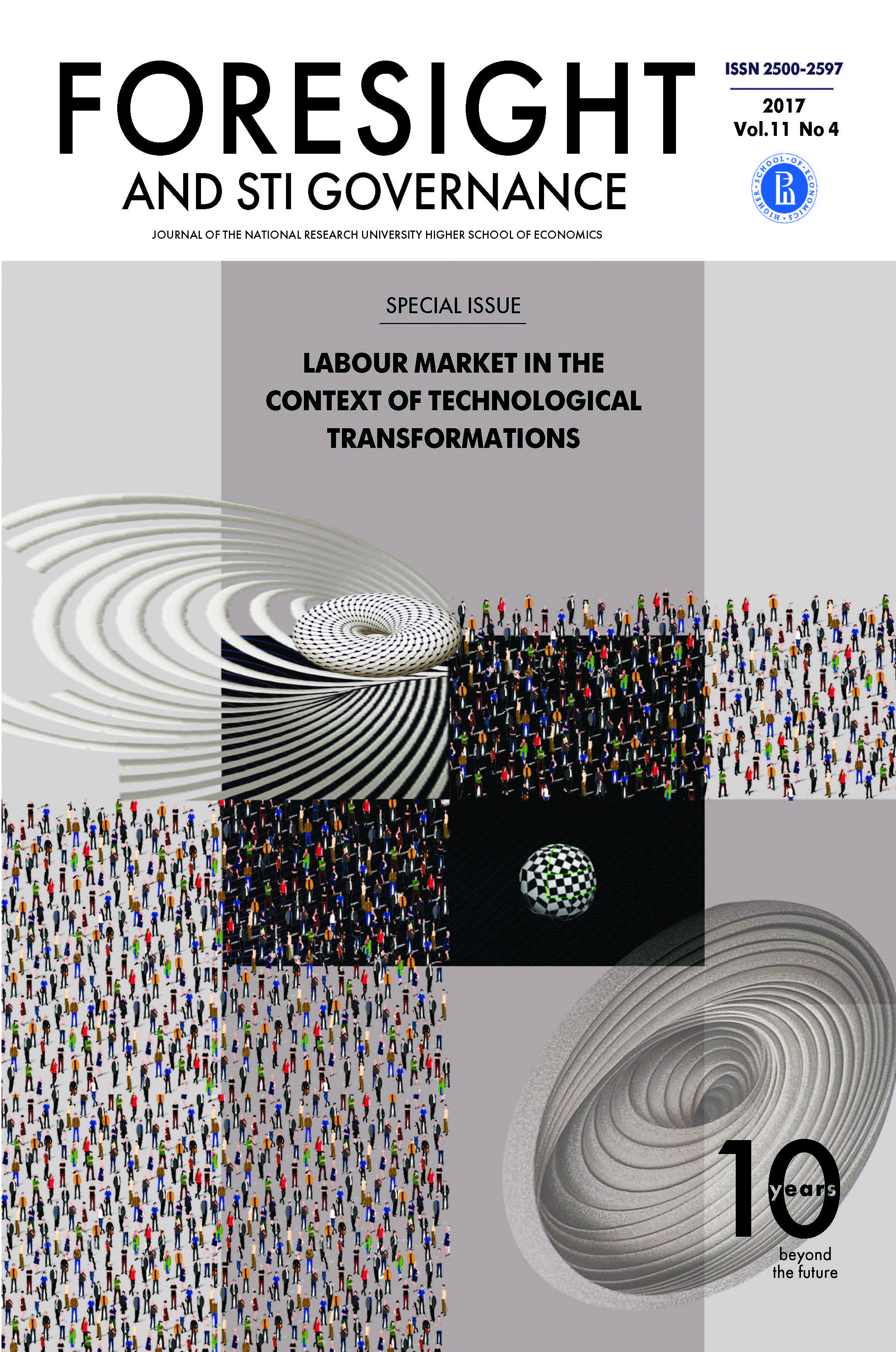Abstract
The present paper addresses the impact of Science, Technology and Innovation (STI) Foresight and the resulting STI policy thereof on the critical issue of future industry studies, the demand for employment.
The impact evaluation exercise relating STI Foresight and employment proposed here converges and integrates different scientific sectors such as the interdependence between employment and welfare framework; the role and weight of technology change to employment dimension; the prospects of emerging and future technologies impacting employment in future industry; the contribution of science, technology and innovation (STI) policies to promoting the generation and real application of new technologies.
The paper follows the premise that STI Foresight, as well as Future Technology Analysis, offer a robust basis for the elaboration and monitoring of STI policies with anticipatory intelligence.
The core of the paper is dedicated to address the main question of how to identify and choose variables and indicators able to reflect vectors towards the future of employment. The selected vectors are referred to cross effects, trends, and time scales. As far the relationship of technology and employment is concerned, the paper examines cross effect impacts resulting from an input-output analysis, trends indicated in Future Technology Analysis, and time scaling of the technology lifecycle. These parameters are meant to constitute the basic elements for impact evaluation algorithms. In this connection, the paper proposes concepts, measurement techniques, and methods for the evaluation of foresight exercises influencing future changes on employment.
Linking policy-making, Foresight, and specific future-looking themes, the paper offers building blocks for constructing standards for the evaluation of foresight exercises.
References
Aghion P., Howitt P. (1994) Growth and Unemployment // The Review of Economic Studies. Vol. 61. № 3. Р. 477-494.
BLS (2015) Employment Projections Program, Industry Employment and Output Projections to 2024. Monthly Labour Review, December 2015. Washington, D.C.: U.S. Bureau of Labour Statistics. Режим доступа: https://www.bls.gov/opub/mlr/2015/article/industry-employment-and-output-projections-to-2024.htm, дата обращения 24.11.2016.
Bacon R., Kojima M. (2011) Issues in estimating the employment generated by energy sector activities. Washington, D.C.: The World Bank.
CES (2014) Future of Work: Jobs and Skills in 2030. London: UK Commission for Employment and Skills.
Calvino F., Virgillito M.E. (2016) The Innovation-Employment Nexus: A Critical Survey of Theory and Empirics. ISI Growth Working Paper 9/2016. Paris: Sant’Anna School of Advanced Studies, Paris School of Economics, University Paris 1. Режим доступа: http://www.isigrowth.eu/wp-content/uploads/2016/03/working_paper_2016_9.pdf, дата обращения 24.11.2016.
Cobb C.W., Douglas P.H. (1928) A Theory of Production // American Economic Review. Vol. 18 (Supplement). P. 139-165.
Frey C.B., Osborne M. (2015) Technology at Work: The Future of Innovation and Employment. Oxford, UK: University of Oxford.
Frey C.B., Osborne M.A. (2013) The future of employment: How susceptible are jobs to computerisation? Oxford, UK: University of Oxford.
Havas A., Schartinger D., Weber M. (2010) The impact of foresight on innovation policy-making: Recent experiences and future perspectives // Research Evaluation. Vol. 19. № 2. Р. 91-104. DOI: https://doi.org/10.3152/095820210X510133
IBGE (1974) Matriz de Relações Interindustriais - Brasil 1970. Rio de Janeiro: Instituto Brasileiro de Geografia e Estatística (IBGE). Режим доступа: http://biblioteca.ibge.gov.br/visualizacao/monografias/GEBIS - RJ/matrizintersetoriais/Brasil_1970.pdf, дата обращения 24.11.2016.
Keynes J.M. (1936) The General Theory of Employment, Interest and Money. Cambridge, UK: Macmillan Cambridge University Press.
Leontief W. (1986) Input-Output Economics (2nd ed.). New York: Oxford University Press.
Mahroum S., Dachs B., Weber M. (2007) Trend spotting the future of information society technology human resources // International Journal of Foresight and Innovation Policy. Vol. 3. № 2. Р. 169-186.
Martin B.R. (2010) Science Policy Research - Having an Impact on Policy? Seminar Briefing № 7. London: Office of Health Economics.
OECD (1997) New Rationale and Approaches in Technology and Innovation Policy. STI Review № 22. Paris: OECD.
Seidl da Fonseca R. (1981) Förderung der Investitionsgueterindustrie als Impulsträger zur Industrialisierung von Entwicklungsregionen - Am Beispiel der Werkzeugmaschinenindustrie in Nordost Brasilien. München: Technische Universität München.
Seidl da Fonseca R. (2016) Impact Analysis of Foresight for STI Policy Formulation: Cases of Romania, Vietnam and Kazakhstan // Deploying Foresight for Policy and Strategy Makers. Creating Opportunities through Public Policies and Corporate Strategies in Science, Technology and Innovation / Eds. L. Gokhberg, D. Meissner, A. Sokolov. Heidelberg: Springer International Publishing. Р. 197-225.
Seidl da Fonseca R., Saritas O. (2005) Instruments for Strategy and Policy: Modelling the Structure of the Policy-making on Science and Technology. Technology Paper Series, TPS 3/05. Vienna: United Nations Industrial Development Organisation (UNIDO).
UN (1979) United Nations Conference on Science and Technology for Development. Resolution № 34/218 adopted by the General Assembly 19 December 1979. Vienna: United Nations. Режим доступа: http://www.un-documents.net/a34r218.htm, дата обращения 24.11.2016.
UN-ESCAP (1984) Technology for Development. Bangkok: United Nations Economic and Social Commission for Asia and the Pacific (ESCAP).
WEF (2016) The Future of Jobs - Employment, Skills and Workforce Strategy for the Forth Industrial Revolution. Global Challenge Insight Report. January 2016. Geneva: World Economic Forum.
Zeitlin J., Trubek D.M. (eds.) (2003) Governing Work and Welfare in a New Economy: European and American Experiments. Oxford, UK: Oxford University Press.

This work is licensed under a Creative Commons Attribution 4.0 International License.

